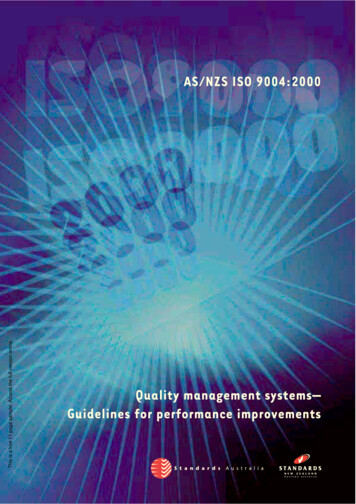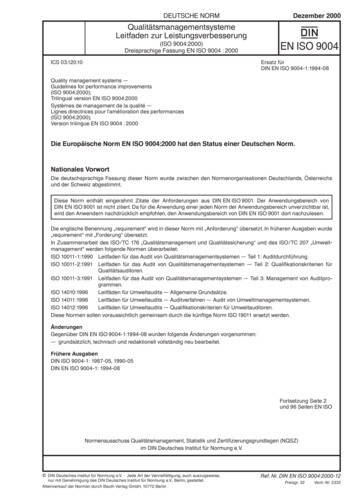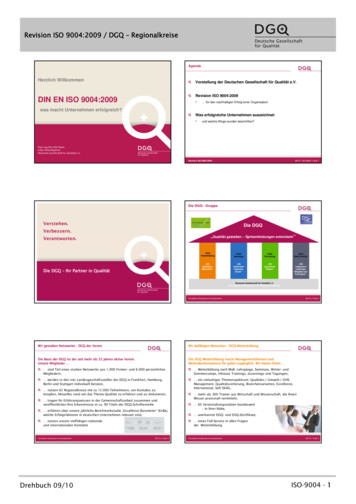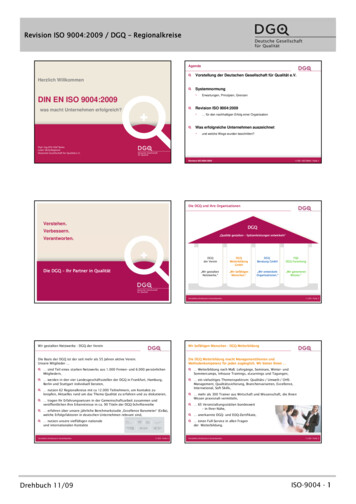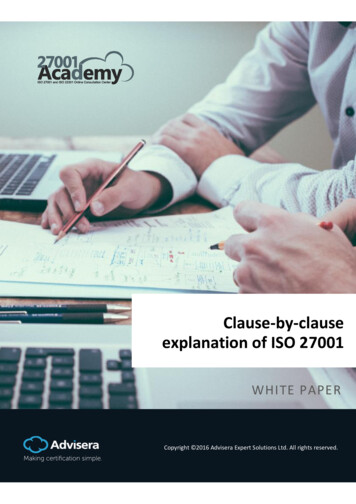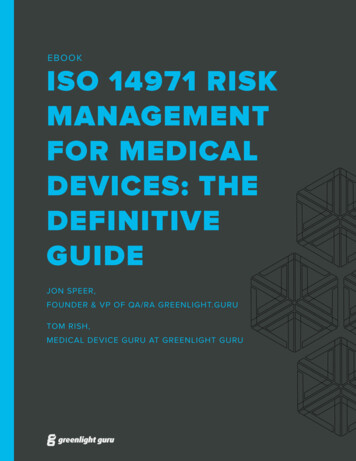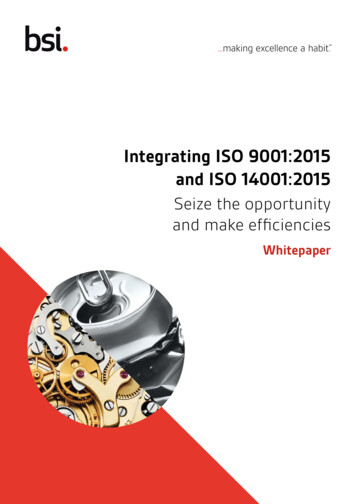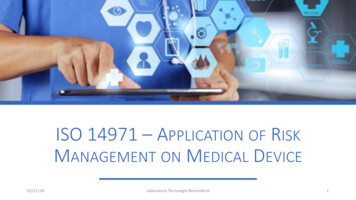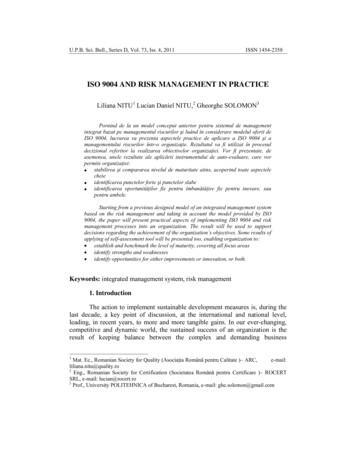
Transcription
U.P.B. Sci. Bull., Series D, Vol. 73, Iss. 4, 2011ISSN 1454-2358ISO 9004 AND RISK MANAGEMENT IN PRACTICELiliana NITU1 Lucian Daniel NITU,2 Gheorghe SOLOMON3Pornind de la un model conceput anterior pentru sistemul de managementintegrat bazat pe managementul riscurilor şi luând în considerare modelul oferit deISO 9004, lucrarea va prezenta aspectele practice de aplicare a ISO 9004 şi amanagementului riscurilor într-o organizaţie. Rezultatul va fi utilizat în procesuldecizional referitor la realizarea obiectivelor organizaţiei. Vor fi prezentate, deasemenea, unele rezultate ale aplicării instrumentului de auto-evaluare, care vorpermite organizaţiei: stabilirea şi compararea nivelul de maturitate atins, acoperind toate aspectelecheie identificarea punctelor forte şi punctelor slabe identificarea oportunităţilor fie pentru îmbunătăţire fie pentru inovare, saupentru ambele.Starting from a previous designed model of an integrated management systembased on the risk management and taking in account the model provided by ISO9004, the paper will present practical aspects of implementing ISO 9004 and riskmanagement processes into an organization. The result will be used to supportdecisions regarding the achievement of the organization’s objectives. Some results ofapplying of self-assessment tool will be presented too, enabling organization to: establish and benchmark the level of maturity, covering all focus areas identify strengths and weaknesses identify opportunities for either improvements or innovation, or both.Keywords: integrated management system, risk management1. IntroductionThe action to implement sustainable development measures is, during thelast decade, a key point of discussion, at the international and national level,leading, in recent years, to more and more tangible gains. In our ever-changing,competitive and dynamic world, the sustained success of an organization is theresult of keeping balance between the complex and demanding business1Mat. Ec., Romanian Society for Quality (Asociaţia Română pentru Calitate )– ARC,e-mail:liliana.nitu@quality.ro2Eng., Romanian Society for Certification (Societatea Română pentru Certificare )– ROCERTSRL, e-mail: lucian@rocert.ro3Prof., University POLITEHNICA of Bucharest, Romania, e-mail: ghe.solomon@gmail.com
262Liliana Nitu, Lucian Daniel Nitu, Gheorghe Solomonenvironment challenges and the expectations of interested parties, assuring the“Triple Bottom Line: environment, society, economy”.In this context, the new edition of international standard ISO 9004:2009 “Managing for the sustained success of an organization – A quality managementapproach” brings quality management system to a new stage of achieving andmaintaining business objectives in the long-term. The standard provides a modelfor a more holistic approach and for identifying the system’s maturity levels,which can be used as a basis for benchmarking and improvement identification.ISO 9004:2009 [1] adds some new elements to the general framework,emphasizing in particular: the ethical-social perspective; the organization mission and vision; the ability to turn strategies into actions and correlate the results to theobjectives. the risk management; the adaptability and flexibility, the organization’s ability to change inresponse to changing conditions of risk and opportunity; the knowledge management; the alignment and linking with other management systemsObviously, Risk Management become a key starting point for managementsystems implementation for an organization which is interested in continuousimprovement of its overall performance, efficiency and effectiveness, andpublication of ISO 31000 [2] is an evidence of understanding the need forwidespread use of this concept in conjunction with all types of managementsystems. Therefore, a model designed special to help organizations to integrate therequirements of different management systems and risk management, in the sametime, will be very useful in the global context of sustainable development.2. Connection between ISO 9004 process approach model and themodel for integrated management system based on risk managementThe process approach model presented in ISO 9004: 2009 (Fig. 1) includesall issues covered by the ISO 9001 model, but also includes some additionalelements like as: needs and expectation of interested parties, strategy, innovationand learning etc. These new elements bring the ISO 9004 model closer to thedesigned model based on risk management [3] through some common issuesadded to the ISO 9001 by both, ISO 9004 and the designed model for integratedmanagement system based on risk management (Fig. 2).
ISO 9004 and risk management in practice263Fig. 1. Process Approach Model (ISO 9004: 2009)If we are talking about the sustainability concept, we talk about the threedimensions of needs that are defining the concept: Social well-being and equity for both employees and affectedcommunities Economic prosperity and continuity for the business and all interestedparties Environmental protection and resource conservation, both local andglobalAs expected, ISO 9004:2009 model as well as the other standards of ISO9000, refers mainly to the economic dimension of the concept. To ensure thebalance between all of them we still need the ISO 14000 series of standards forenvironmental protection and OHSAS, SA8000 / ISO 26000 for the socialdimension. Because of including the needs and expectation of interested partiesinto the process approach model, for those organizations, which alreadyimplemented ISO 9001, the implementation of ISO 9004:2009 could be a usefulstep towards sustainable development.
264Liliana Nitu, Lucian Daniel Nitu, Gheorghe SolomonFig. 2. Model for Integrated Management System based on risk managementIn the proposed model for integrated management system based on riskmanagement, the focus is on risk management process, but the target is the same:achievement of needs and expectation of all interested parties. Anyway, the riskmanagement concept, even if it is not expressly stated in the ISO 9004 processapproach model, is still mentioned inside the text of the standard, but for thepractical aspects related to application, the standard refers to the ISO 31000.3. Practical aspects of implementing ISO 9004 and Risk ManagementBoth models, previously presented, are following the PLAN – DO –CHECK – ACT Cycle, so they are compatible each other, making possible to usethem simultaneously. The methodology used to implement ISO 9004 and risk
ISO 9004 and risk management in practice265management are briefly presented below, referring the results obtained into anindustrial company.In the first stage of implementation, a company should identify theactivities of the company, the location, and all interested parties, includingregulators or groups living in the region. Related to these interested parties, thecompany will update the mission, the strategy and the objectives. A strategic levelself-assessment, will enable the organization to establish the current level ofmaturity and the target for next period, and to identify strengths and weaknesses,opportunities for improvements or innovation and to develop a management planfor the short or / and medium term horizon.To determine the current maturity level an Excel workbook, wasdeveloped which allows quick calculation and plotting graphs necessary tointerpret the results. The results of such a self-assessment in a specific companyare presented in Fig. 3.Fig. 3. Results of strategic self-assessmentOn a graphic, the results can be shown as follow (figure 4):
266Liliana Nitu, Lucian Daniel Nitu, Gheorghe SolomonFig. 4. Graphical result of the strategic self-assessmentFrom this first self-assessment result, it can be seen that the weaknesspoints of that company are: Resource Management Strategy and policy deployment and Improvement, innovation and learning,while the strengths seem to be, at this moment, the Process Management.As a result, the management should review the strategy and develop a planto improve the situation regarding the weakness points. To ensure that theimprovement plan is effective, it is necessary to identify and adequately analyzeand describe the processes involved and the sequence and interactions betweenthem. This step might not be necessary if the organization has alreadyimplemented ISO 9001, perhaps at the most it would be necessary to re-evaluatethese processes, and after that to conduct a self-assessment at an operational(detailed) level.The results of the self –assessment for Resource Management is presentedbelow (Fig. 5). We considered this item taking into account that this key elementwas the identified as weakness point. Of course, the detailed self-assessmentshould be made for each detailed element.
ISO 9004 and risk management in practice267Fig.5 Results of the self –assessment for Resource ManagementAnalyzing the graphic result (Fig. 6), we can conclude that theorganization should focus on improving the human resources and infrastructuremanagement.Fig.6 Maturity level for Resource Management
268Liliana Nitu, Lucian Daniel Nitu, Gheorghe SolomonThe decision regarding the actions needed to improve the human resourcesand infrastructure management should be taken on a profound analysis, includinga risk assessment. Some results of risk management process applied forinfrastructure is presented below.3.1 Risk IdentificationTo identify the risks associated with the infrastructure, the organisationshould identify first the infrastructure items (table 1), and for each item shouldidentify sources of risks, events, causes or sets of circumstances [2,4] related tothe item and their potential consequence on the established targets (table 2).Table 1Infrastructure register – sampleThe values of the infrastructure items are selected using the followingrange: I - insignificantMi - minorMo - moderate
ISO 9004 and risk management in practice269 Ip - important H - high VH - very high C - criticalFor each infrastructure item, a risk analysis and evaluation to establish therisk exposure and the strategy to treat the risk should be made. The scales used forthe analysis are as follow:Likelihood:1 - Extremely low2 - Very low3 - Low4 - Moderate5 - High6 - Very highImpact:1 - Insignificant2 - Minor3- Moderate4- Important5 - High6 - Very high7 - CriticalThe exposure risk is established using table 2 and the acceptable level of risk wasdefined at 3.5.Table 2Exposure risk rate(3)Important(4)High(5)Veryhigh (6)Critical(7)Very 3)1234455Very low(2)1223444Extremelylow (1)1122333An example of such analysis is presented in table 3. As it can be seen fromthe given example - a CNC lathe, as part of the infrastructure, some hazards havebeen identified with unacceptable level of risk, such as: Failure, due to wear Mechanical hazards, due to hazardous moving parts
270Liliana Nitu, Lucian Daniel Nitu, Gheorghe Solomon Electrical hazards, due to defective plugs or switches, cables withdamaged insulationMisadjusted equipment, due to frequent adjustment requiredTable 3Risks Register - sampleFor all hazards, it was decided to take actions immediately, aimed atreducing the probability of occurrence of the circumstances that favour thoserisks. As it can be seen, the residual risk obtained after implementation of thesemeasures was below the acceptable risk.Overall risk level (ORL) for each element of infrastructure is calculated asa weighted average of risk levels established for the identified risk factors. Tomake the results to reflect reality as accurately as possible, the risk level will beused as a weighting factor. In this way, it will be eliminated the compensationeffect between extremes [5].The risk levels for all hazards identified for the CNC lathe (identificationno. II-01-01) are presented in figure 7. In a similar way the overall risk level forinfrastructure, was established the established value being 3.41.
ISO 9004 and risk management in practice271Fig.7 Risk levels for hazards identified for the CNC lathe3.2 Risk Treatment and management decisionsAs a result of risk assessment process [6] for infrastructure, themanagement can take a right decision about how to improve the weakness point,by developing and implementing an adequate treat risk plan, for short termhorizon, as follow (table 4) and by developing a management agenda and action plansfor the medium term horizon (2-3 years):Table 4Treat risk plan –Infrastructure - sampleResponsibleCrt. Risk area/ Hazard Risk Reduction MethodNo. description/ levelCircumstancesthatfavourtherisk(causes)1.CNC lathe II/01/01 / 4Preventive maintenance Productionfailure / wearTechnician2.CNC lathe II/01/01 / 4Check the integrity and H&S resp.Mechanical hazards /functionalityofHazardousmovingprotection screen andpartsguards and immediateremedy failuresH&S resp.4Regularly check3.CNC lathe II/01/01 /electrical wiring,Electrical hazards /replacement of defectiveDefective plugs orswitches or plugsswitches, cables withimmediately bydamaged insulationauthorized persons4Increase adjustmentProduction4CNC lathe II/01/01 /frequencyTechnicianMisadjusted equipment/ Frequent ery 2 hours
272Liliana Nitu, Lucian Daniel Nitu, Gheorghe SolomonStarting from the analysis made in this paper the medium-term priorities inthe organization have been defined as follows: Implement a system for planning and efficient use of resources Implement a system to recognize and motivate employees Implement an IT system for customer relationship managementThe progress achieved by implementing all these actions set out after theinitial self-assessment was reviewed at the next self-assessment (figure 8).Fig.8 Comparative results of self-assessments4. ConclusionsThe integration of risk assessment as a core of an integrated managemen
U.P.B. Sci. Bull., Series D, Vol. 73, Iss. 4, 2011 ISSN 1454-2358 ISO 9004 AND RISK MANAGEMENT IN PRACTICE
